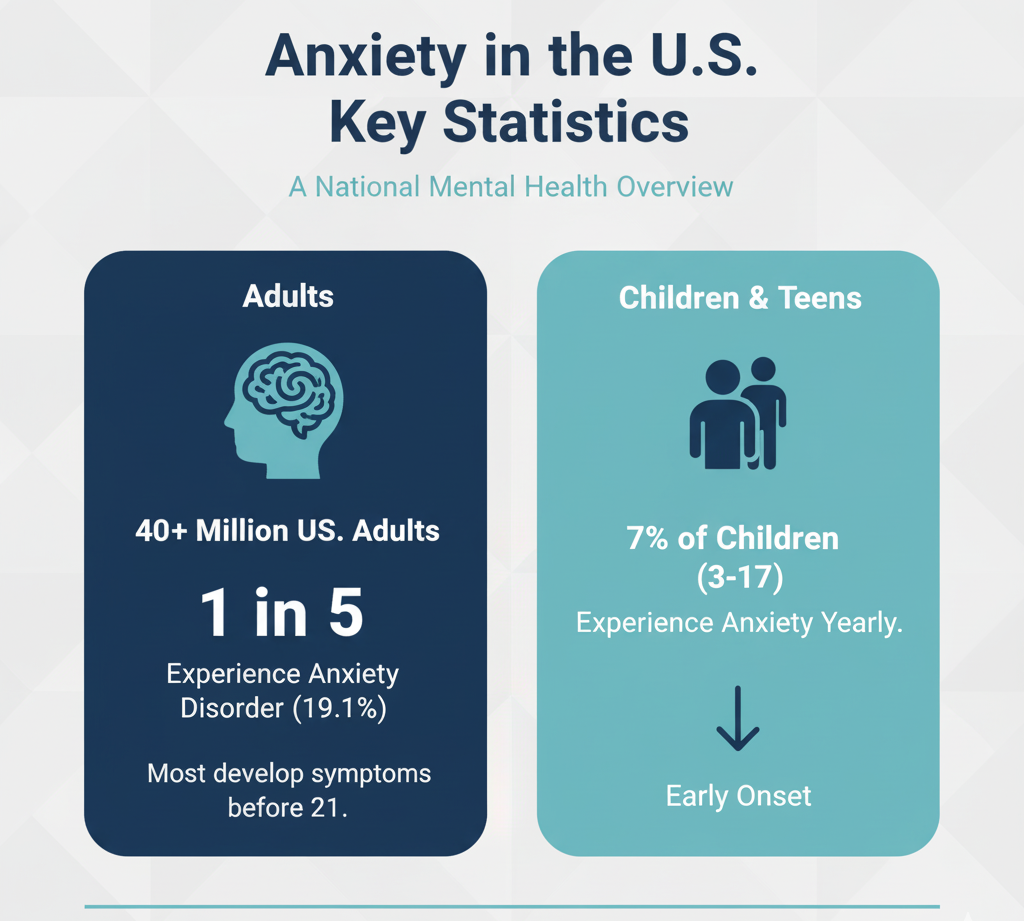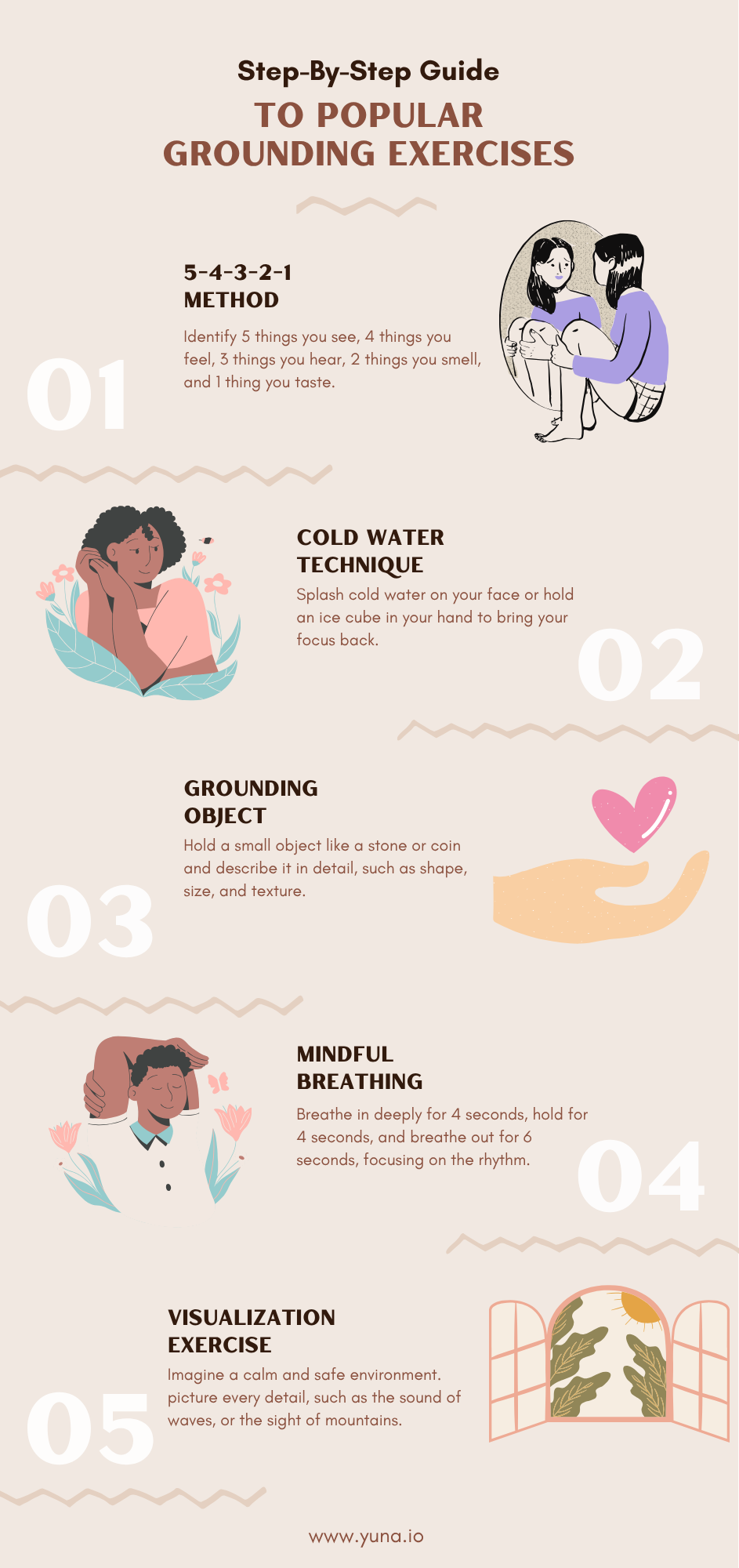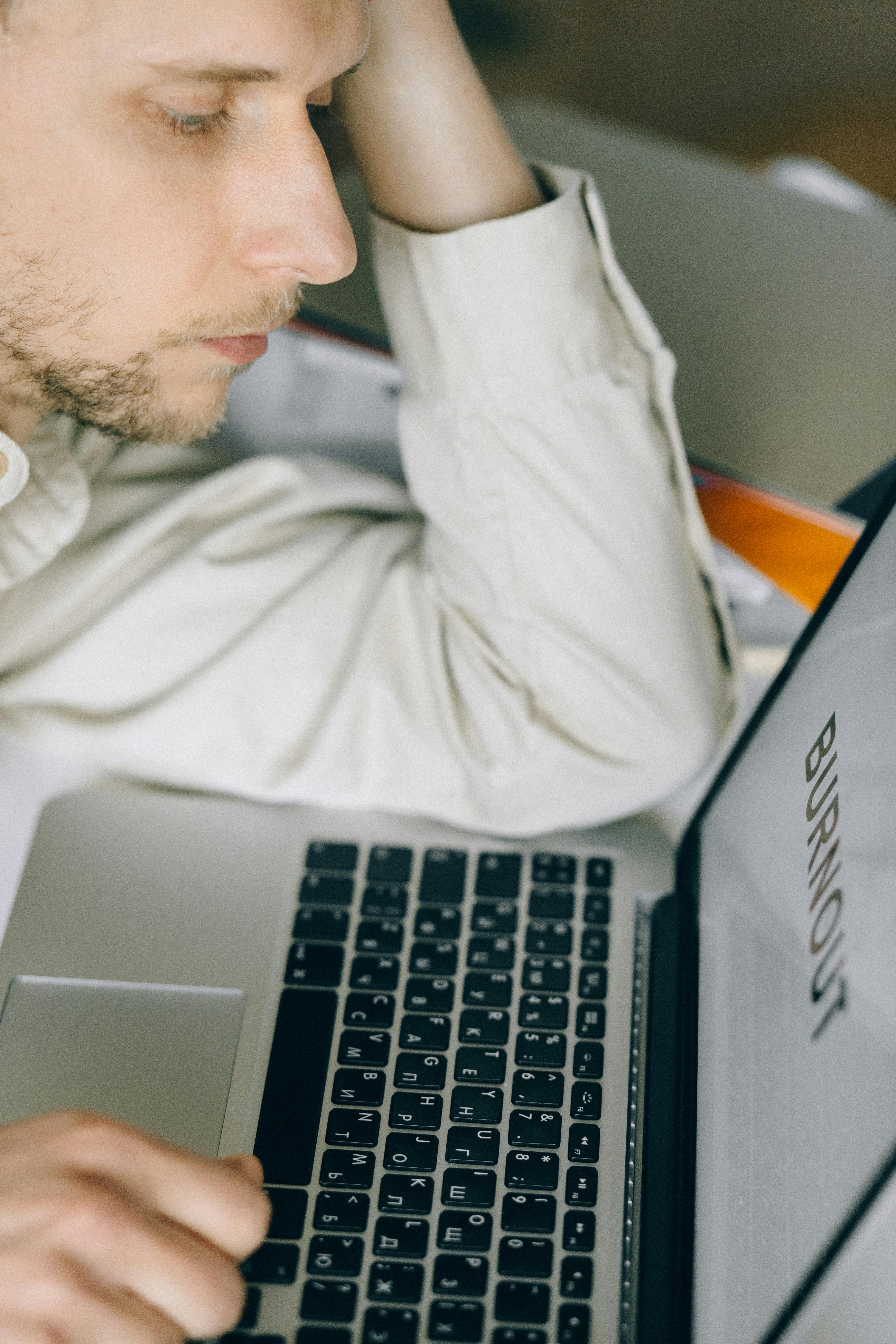Anxiety often feels like losing control of your own mind. Thoughts race, your body feels tense, and it seems impossible to focus on anything around you. For many, it feels like being trapped inside spiraling worries or completely detached from reality.
Grounding techniques can help bring you back to the present. These simple but powerful exercises work by shifting your focus away from overwhelming thoughts and back to what you can see, touch, or hear right now. They act like an anchor, keeping you steady when anxiety tries to pull you away.
This guide will explain what grounding techniques are, the different types available, and step-by-step instructions for the most effective ones. You will also learn when to use them, why they work, and how they can be paired with professional support. By the end, you will see how grounding exercises for anxiety can reduce stress and improve emotional balance in everyday life.
What Are Grounding Techniques?
Grounding techniques are strategies that help you reconnect with the present moment when anxiety, panic, or trauma responses take over. Instead of letting racing thoughts control you, grounding brings your attention back to your body, your senses, or your surroundings.
The Cleveland Clinic defines grounding as a method of shifting focus outward instead of inward. This means paying attention to what you can physically see, hear, or feel, rather than focusing on the anxious spiral inside your head. These methods are often used by therapists to help with panic attacks, trauma flashbacks, or high stress.
Grounding is not about ignoring problems. It is about creating enough calm in the moment to think clearly and respond in a healthier way. For someone experiencing anxiety, it can mean the difference between feeling overwhelmed and regaining a sense of control.
Anxiety is widespread. According to the National Alliance on Mental Illness, more than 40 million adults in the United States experience anxiety disorders each year. This shows why simple coping tools like grounding are becoming essential in everyday life.
In short, grounding techniques help reduce distress by reconnecting you with the present. They are useful for anxiety, panic attacks, stress at work, or even moments of dissociation where you feel disconnected from your body or surroundings.

Types of Grounding Techniques
Grounding techniques fall into three main categories: physical, mental, and soothing or sensory. Each works differently, but they all have the same goal: to anchor your mind and body in the present.
- Physical grounding techniques use movement, touch, or body awareness.
- Mental grounding techniques involve focus-based exercises like counting, naming, or affirmations.
- Soothing or sensory grounding techniques rely on comfort, visualization, or calming statements.
Choosing the right one depends on your situation and what feels natural to you. Some people respond better to movement, while others find comfort in calming words or sensory experiences.
Physical Grounding Techniques
Physical grounding techniques are effective because they engage your senses and body. By doing something physical, you redirect your brain’s attention from anxious thoughts to the world around you.
5-4-3-2-1 Method
This exercise helps you focus on your surroundings. Look around and name 5 things you can see, 4 things you can feel, 3 things you can hear, 2 things you can smell, and 1 thing you can taste. By naming them one by one, you bring your mind back to the moment.
Touching a Textured Object
Carry something small like a stone, keychain, or piece of fabric. When anxiety rises, hold it and notice its texture, shape, and temperature. The act of feeling a physical object can calm racing thoughts.
Movement-Based Grounding
Use movement to reconnect with your body. Walk slowly, stretch, or stomp your feet on the ground. Pay attention to each step or movement. Notice how your body feels as you move, which brings focus away from worry.
Breathing with Hand Pressure
Place one hand on your chest and the other on your stomach. Breathe in deeply, pressing your hand slightly as your stomach rises. This grounds you in your breath and helps slow down racing thoughts.
Naming Objects in the Room
Look around the room and name objects out loud. For example: “table, lamp, book, window.” The act of naming what you see helps your brain connect to reality instead of worry.
Mental Grounding Techniques
Mental grounding techniques shift your focus to cognitive activities. By engaging your brain with tasks like counting or naming categories, you create space between yourself and anxious thoughts.
Naming Categories
Pick a category and name as many items as possible. For example, name fruits, countries, or animals. Focus on filling the list instead of thinking about anxiety.
Counting Backward from 100
Count backward from 100 in sevens, or simply count down one by one. This engages your brain in a logical process, pulling focus away from racing thoughts.
Reciting Affirmations or a Mantra
Repeat calming statements like “I am safe,” or “This feeling will pass.” Saying affirmations out loud reinforces control and safety.
Mental Math Problems
Challenge yourself with simple math problems in your head. For example, multiply small numbers or calculate sums. This distracts your brain with focus and problem-solving.
Describing a Daily Routine
Mentally go through the steps of your morning routine. Think about brushing your teeth, making coffee, or dressing for the day. This structured thought process grounds you in reality.
Soothing and Sensory Grounding Techniques
Soothing grounding techniques are designed to bring comfort by using calming words, visualization, or sensory experiences. They are especially helpful when anxiety feels overwhelming or when emotions rise quickly.
Visualization
Close your eyes and imagine a safe place. It could be a beach, a quiet forest, or even your own bedroom. Picture the details: the colors, sounds, and scents. Visualization creates a mental escape that soothes your body and mind.
Repeating Calming Statements
Repeat a phrase like “I am safe” or “This will pass.” Speaking these words aloud helps replace fearful thoughts with comforting ones. The repetition strengthens feelings of control.
Focusing on Pleasant Scents
Use a candle, essential oil, or a fresh flower. Take slow breaths while focusing on the scent. Pleasant smells can trigger feelings of relaxation and pull your focus into the present moment.
Listening to Music
Play calming music or sounds like rain or ocean waves. Let the rhythm and melody soothe your mind. Paying attention to the instruments or lyrics grounds you in the sound instead of worry.
Holding a Warm Drink
Wrap your hands around a warm cup of tea or coffee. Feel the heat travel through your fingers. This simple sensory action provides comfort and eases physical tension.

Step-by-Step Guide to Popular Grounding Exercises for Anxiety
Grounding exercises are simple, but they work best when practiced with intention. Below are some of the most widely recommended techniques, with instructions on how and when to use them.
5-4-3-2-1 Method
Identify 5 things you see, 4 things you feel, 3 things you hear, 2 things you smell, and 1 thing you taste. Use this during panic attacks or sudden anxiety to quickly return to the present.
Cold Water Technique
Splash cold water on your face or hold an ice cube in your hand. The sharp temperature shift interrupts anxious spirals and brings your focus back to your senses.
Grounding Object
Carry a small object like a stone or coin. Hold it and describe it in detail. Notice the shape, size, and texture. Use this during stressful meetings or while commuting when you need quick relief.
Mindful Breathing
Breathe in deeply for 4 seconds, hold for 4 seconds, and breathe out for 6 seconds. Focus on the rhythm of your breath. This slows your heart rate and reduces tension.
Visualization Exercise
Imagine a calm and safe environment. Picture every detail: the sound of waves, the feeling of sand, or the sight of mountains. This is useful before sleep or when facing stressful situations.
Body Scan Exercise
Start at your toes and mentally move upward, noticing sensations in each body part. This technique reduces tension and reconnects you with your body when anxiety feels overwhelming.
Why Use Grounding Techniques for Anxiety?
Grounding techniques for anxiety work because they redirect attention away from anxious thoughts and back to the present. Instead of fighting against worry, you anchor yourself in reality. This shift can calm both the mind and body.
Anxiety often raises physical symptoms such as rapid heart rate, sweating, and shallow breathing. Research shows grounding can lower these responses by slowing down stress signals in the brain. By focusing on external cues, you reduce the power of intrusive thoughts.
These methods also provide immediate relief. Unlike long-term strategies that take weeks to show results, grounding works in the moment. Whether during a panic attack, a stressful meeting, or restless nights, they offer quick tools for balance.
When to Use Grounding Techniques
Grounding techniques are flexible and can be used in many situations. They are not only for extreme anxiety but also for everyday stress.
During a panic attack, grounding helps regain control by breaking the cycle of fear. Before a stressful meeting or presentation, grounding calms nerves and improves focus. At night, when anxious thoughts interfere with sleep, grounding shifts the mind toward calmness.
These techniques are also valuable for trauma responses or moments of dissociation, when you feel disconnected from your body. Even small daily challenges like waiting in traffic or handling work pressure can benefit from grounding practices.
The key is consistency. The more you practice them, the easier it becomes to use them when stress is high.
Tips for Making Grounding Exercises More Effective
Grounding works best when practiced regularly. Below are practical tips to get stronger results.
Consistency
Use grounding daily, not just during stressful moments. Practicing when calm makes it easier to apply during anxiety.
Pair with Mindfulness
Combine grounding with mindfulness exercises like meditation. Together, they create a stronger effect on focus and calmness.
Journaling Progress
Write down when you use grounding and how it helps. Over time, this shows patterns and builds confidence in the techniques.
Practice When Calm
Do not wait for a panic attack. Practicing grounding when relaxed makes the process familiar and automatic.
Combine Techniques
Blend physical and mental grounding. For example, count backward while holding a grounding object. This creates a stronger anchor against anxious thoughts.
Cleveland Clinic experts suggest practicing grounding before stress peaks, which makes the tools even more effective when pressure rises.

Professional Support and Resources for Anxiety Management
Grounding techniques are effective for immediate relief. They work best when combined with longer term care for persistent anxiety. Consider therapy if anxiety is frequent, severe, or limits daily life. Cognitive behavioral therapy, or CBT, is an evidence based approach that teaches practical skills to change thinking and behavior. Many people find CBT especially helpful together with grounding exercises.
Meditation, mindfulness, and breathing practices strengthen emotional regulation. Regular meditation can reduce reactivity and make grounding easier to use in the moment. Counseling provides a safe space to explore triggers and build coping plans. Group therapy and peer support can also reduce isolation and normalize the struggle.
Online therapy is convenient and often faster to access than in-person sessions. It lets you meet licensed clinicians from home and schedule around work and family life. AI therapy and AI mental wellness coaching add daily support and micro tools between sessions. These tools can remind you to practice grounding, offer short guided exercises, and track your progress.
If you use digital care, verify the provider’s credentials and data privacy practices. If anxiety causes thoughts of harming yourself, please seek immediate help from local emergency services or a crisis line. For readers who want practical digital options, link here to Yuna’s wellness tools and productivity features so teams and individuals can combine grounding techniques with continuous support.
How Yuna Supports Anxiety Management and Mental Wellbeing
Grounding techniques for anxiety are powerful on their own. Yuna makes them easier to use every day. Yuna offers AI guided reminders that prompt short grounding exercises when stress rises. The app also provides structured routines that pair mindful breathing with quick sensory tasks. This helps habits form and keeps practice consistent.
Yuna’s coaching uses data to personalize exercises. The platform learns which anxiety grounding techniques work best for each person. It then suggests the right technique at the right moment. Yuna supports seamless handoffs to human therapists when deeper care is needed. It also stores private notes so users can track progress and notice improvement over time.
For teams, Yuna supplies anonymous insights on well being and load. Leaders can see trends without viewing individual details. This helps managers create safer, more flexible work practices that reduce triggers. Combining grounding exercises with Yuna’s reminders, coaching, and analytics creates a practical path to steady mental balance. Explore Yuna’s wellness and productivity pages to learn how the platform can support daily grounding practice and long term resilience.






